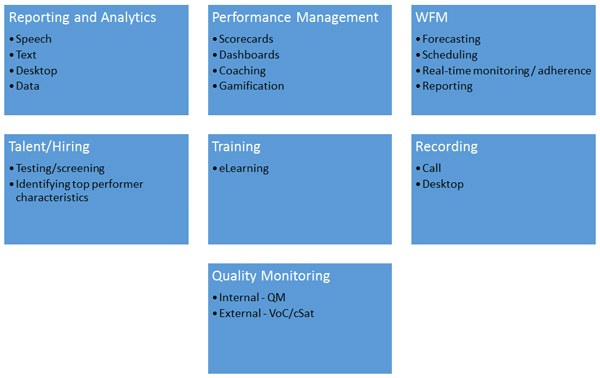Workforce Optimization (WFO) technology continues to advance. Tools such as Workforce Management (WFM) and Quality Monitoring (QM) have achieved widespread deployment. A full WFO suite delivers an array of intertwined functions to improve the efficiency and effectiveness of the center, and optimize the hiring, training, performance, and development of the most valuable (and expensive) resource – agents.

Unfortunately, the market is ahead of the user’s readiness to leverage what vendors have to offer. Gaps remain in filling out the suite of performance tools and applying them effectively to business needs. Because WFO holds so much potential value and gets at the heart of targeted areas for improvement, various tools sit high (or should sit high) on many wish lists.
WFO Opportunities
Everyone knows they need to start extending the WFO tools (especially WFM and QM) to media besides calls, but the tools, processes, and resources can be hurdles. The vendors have said for years they have it, but approaches and specifics vary and often fall short. Whether because of low volume on these other media, or low maturity in managing them, or frustration with tools, few have gotten very far.
Our 2014 WFO and Analytics survey showed a high demand for speech analytics, and our project experience aligns with that. However, analytics still gets positioned with promises – or expectations – that generally exceed reality. The potential remains great, and we still see this as the next great WFO frontier. However, the focus of these implementations needs to be root cause analysis that leads to actions.
Excitement over gamification appears to be on the rise as centers seek ways to engage staff across generations and create a breakthrough for performance and retention. Competitions need to be intelligent, challenging, inclusive, and alluring to each individual, have a collaborative element, and not drive the wrong behavior (“social loafing” anyone?!). Advanced WFO tools can answer this need as long as no rigid corporate edict gets in the way.
We see a desire – or need – for greater integration across WFO tools and to other tools. Within WFO, a common administration tool across WFM, QM, reporting, scorecards, etc. is a high priority. Another need is to bring data from various parts of a suite into PM scorecards and dashboards. Similarly, many things feed coaching, including those scorecards, QM, and WFM. Across to other systems, WFM needs to integrate with payroll systems, contact center reporting/analytics needs to link into enterprise analytics or data warehouses, and eLearning and training modules should be part of corporate Learning Management Systems (LMS). All of these needs are very familiar to the vendors but not fully resolved. They address them through increasingly tight integration across their suites and “connectors” or APIs to other tools, but some are still a work in progress or require custom integrations with high price tags.
WFO Hurdles
So why is the market tends ahead of the users, and why so tools fall short of expectations? It’s not all the vendors’ fault, of course. Sometimes it’s about money. For example, everyone wants analytics and scorecards and dashboards, but not everyone funds the technology, much less the resources to use it effectively. Sometimes it’s about shortcuts – in selecting the right tools, how they are deployed, or how they are used. Often it’s about thinking the tool itself is the silver bullet. As powerful as these WFO tools can be, none are magic. They all require resources with the right skills and training, time to use the tools, and an environment focused on action to effectively apply the tool and DO something with outcomes.
The Way Forward
The starting point is to get more out of current technology. Almost every center with any WFO tool has that opportunity. Then identify the next priority on the wish list. Buyers have to spend a significant amount of time planning for and selecting the right tool, as well as learning how to apply it effectively once purchased and implemented. Success themes are: put the right resources and processes in place to use the tools, get ongoing education (not just implementation training), leverage vendors and third party resources, and have a bias toward action. It’s an ongoing process to optimize a contact center workforce, even with a suite of slick, valuable tools.
